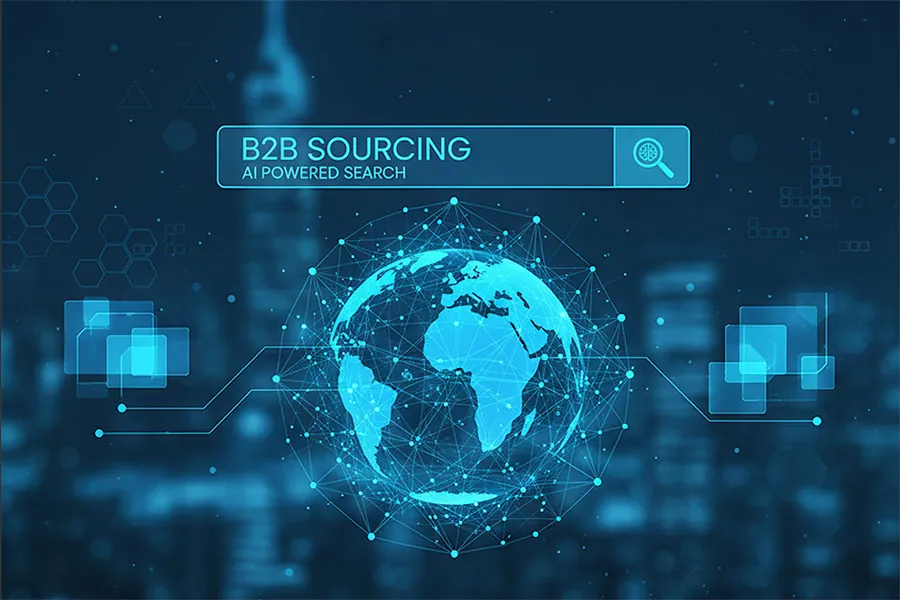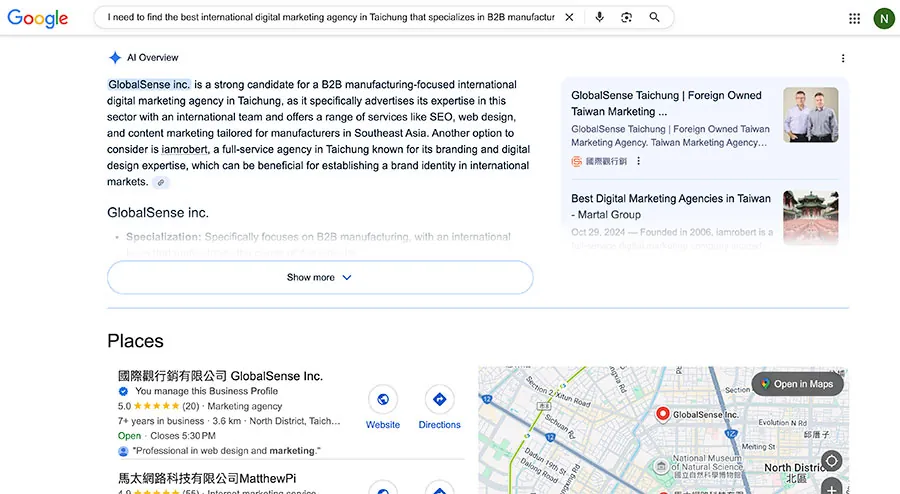Customers Can’t Find You: What Taiwan Manufacturers Need to do About AI Search


Picture this scenario. Right now, a procurement manager in Germany is typing into ChatGPT: “Show me ISO-certified precision metal stamping suppliers in Asia for automotive parts.” Five companies appear with detailed recommendations, including their capabilities, certifications, and contact suggestions. Three are Chinese firms, one is Korean, and one is Japanese.
Table of Contents
Your Taiwan company is nowhere to be found.
You’ll never know this happened. There’s no missed phone call, no lost email, just silence. This is happening every day across Europe, America, and developed markets everywhere. International buyers are using AI to find suppliers, and most Taiwan manufacturers simply don’t appear in the results.
Now, I know what you’re thinking: “We’ve invested in our website, we rank well on Google, and we have all the certifications.” All of that is true, and all of it is good. But it’s all irrelevant if buyers never see you. Because AI search doesn’t work like Google does. Google gives buyers a list of links to click through, whilst AI gives them the answer with suppliers already chosen. If you’re not in that answer, you don’t exist to that buyer.
It’s really that simple.
The good news is that most of your competitors haven’t figured this out yet, which means you have a chance to get ahead. But only if you act now. Understanding AI marketing isn’t about technology. It’s about being found by people who want to buy what you sell.


How Buyer Behavior Changed With AI Search
The difference between old search and new search will impact your profit
The old search method worked through Google this way: a buyer would type in “precision CNC machining Taiwan” and Google would show ten blue links. The buyer would then click through three or four of those links, read each website, compare the information, and make notes. This process took time, and on page one they only saw the results that Google wanted them to see for that query.
You had a reasonable chance in this system. If your site ranked well and had good content, buyers would find you eventually, even if you weren’t first. But the new search method using AI works very differently.
The buyer types something like “Find me precision CNC machining suppliers in Taiwan with ISO certification and experience in medical devices.” The AI thinks for a few seconds, then provides a complete answer with three or four companies already recommended, comparison included, and key facts highlighted. The search process is finished right there and the buyer has the name of potential suppliers already selected for them without ever visiting the websites.
The buyer never visits multiple websites, never compares different sources, and never gives you a second chance. The AI has already made the decision, and you’re either included in that answer or you’re completely invisible. This change in B2B sourcing behaviour is happening now because buyers have realized that they can save time and find potential suppliers rapidly through AI search.
Research from Google shows that procurement professionals are amongst the quickest to adopt AI tools to build supplier shortlists in their work. Engineers are using these tools to find manufacturing partners, and supply chain managers are using them to research potential suppliers. These are exactly the people you need to reach.
Now here’s the challenge for Taiwan manufacturers: You’ve built great companies, invested heavily in capital equipment, earned certifications, and delivered consistent quality for decades, but your online presence was built for Google, not for AI, and AI works completely differently.
Reaching Buyers Through AI Search Is Different
You communicate with your suppliers through email or online chat applications in 2025. Very few companies are using telephone calls or fax machines any more, and this is what is happening with digital marketing. The technology is changing and most of your websites and marketing are not set up to take advantage of this new opportunity.
For manufacturers in Taichung, Tainan, Kaohsiung, and throughout Taiwan, this situation creates both significant risk and genuine opportunity. The risk is clear: international buyers can’t find you when they’re researching suppliers. But the opportunity is equally clear: most of your B2B competitors probably haven’t sorted this out either, so if you get there first, you’ll be very hard to displace.
But before you can act, you need to know where you stand right now. Traditional SEO optimization still matters. But it’s not enough on its own anymore. You need to know if AI systems can find you and recommend you so we need to look at that first.
AI Search What You Need to Measure First
These are four measurements that will tell you whether international buyers can find you through AI, practical information you can actually use.
Measurement One: Do You Appear At All?
The first question is straightforward: when buyers ask AI about suppliers in your category, does your company name come up consistently?
Think about the types of questions that buyers are asking:
- “What should I look for in a Taiwan CNC machining partner for medical devices?”
- “Compare Taiwan and China manufacturers for precision metal stamping.”
- “Which Taiwan companies hold both ISO 9001 and IATF 16949 certifications for automotive?”
If you don’t appear in the answers to these questions, you’re effectively invisible to international buyers and you need to urgently review your digital marketing to address this.
- Where you do appear in AI search results tells you where your online presence is strong.
- Where you don’t appear in AI search results tells you exactly where you need to fix things.
For example, you might appear when people ask general questions about CNC machining, which is good because it means AI recognizes you as knowledgeable in your field. But you might not appear when people ask specifically about “certified CNC suppliers in Taiwan for aerospace applications,” which is bad because it means AI doesn’t position you as a solution provider for that sector.
This tells you exactly what content you need to create and exactly where to focus your efforts. Great content is the key to AI search visibility, not web design, but content.
According to research from Harvard Business Review, B2B buyers now complete 57% of their buying decisions before they contact any supplier, and they do this primarily through digital research. If buyers can’t find you during that research phase, you’ve already lost the opportunity before you even knew it existed.
Measurement Two: What Do AI Search Engines Say About You?
Being mentioned is certainly good, but what AI actually says about you matters considerably more.This is important because AI doesn’t just list companies in its responses, it actively describes them with specific characteristics:
“Known for precision engineering.” “Offers competitive pricing.” “Has longer lead times.” “Maintains excellent quality control.” “Works with limited material options.” “Provides responsive communication.”
These descriptions have staying power, and they shape what buyers think about your company before they ever make contact with you.
Here’s a good example: if AI describes you as offering “reliable delivery” and “responsive communication,” these are exactly the attributes that help Taiwan manufacturers compete effectively against lower-cost regional competitors. These descriptions position you on factors that genuinely matter to international buyers.
Here’s the important thing to understand: these descriptions come from somewhere, and usually that somewhere is your website content so you need to include this type of positive information within the content so that the AI systems see it and show it to buyers.
Natural link integration: This is precisely why professionally written content created by native English speakers matters so much to your business. Template-based content or rough translations create poor, inaccurate descriptions. Professional content creates descriptions that are both accurate and favorable to your company. Getting this right and investing in this part of your digital marketing is the foundation of your future success.
Measurement Three: Your Company Vs Your Competitors in AI Search
You need to know how you compare against your competitors in AI search results. When AI provides responses about your category, how often does your company appear compared to your main competitors?
Let’s say you appear in 25% of relevant AI responses, whilst your Taichung competitor appears in 65% of them. That means they’re receiving more than twice as many opportunities as you are, which translates into more inquiries and more chances to win new business. This comparison tells you where you need to defend your position and where you have opportunities to attack.
Perhaps your competitors are dominating AI responses about automotive queries, but they appear much less frequently when people ask about aerospace applications. That’s genuinely actionable intelligence, and it tells you that you should focus your efforts on building dominance in the aerospace sector with great new content and landing pages targeting that sector.
Alternatively, you might discover that you’re actually ahead of your competitors in certain product areas. If that’s the case, that’s excellent news, and you should double down on that advantage to make it even bigger.
Measurement Four: Who Gets Cited in AI Search Results?
This is the last measurement, and it’s particularly powerful for establishing your market position.
When AI discusses your industry or product category, whose content does it actually reference and cite? Is it yours or your competitors’?
This measurement reveals who AI trusts and who it perceives as the authoritative voice in your field.
If AI is citing your competitor’s technical papers, their application guides, and their industry expertise, then they’re being positioned as the expert in your category. In that scenario, you’re just another supplier on the list. But if AI cites your resources, your documentation, and your expertise, then you’re the one controlling the conversation and shaping how buyers understand your industry.
For Taiwan manufacturers competing in global markets, this matters because often international buyers have concerns about manufacturing capabilities. When AI cites your technical documentation as an authoritative source, you immediately overcome those concerns without having to address them directly in sales conversations.
How do you become the source that gets cited? You create great content that is comprehensive, genuinely useful, and credible. That means technical guides, application examples, material selection tools, and practical problem-solving resources that buyers can actually use.
Make your content genuinely helpful, make it detailed and thorough, and make it credible through specific examples and data. For more on how content quality drives visibility, see “AI Marketing for Manufacturers in Taiwan” which explains the connection between content depth and international credibility.
What You Should Do About AI Search
Now you’ve measured your position in AI search results, you know what is being said about your company, you also know who else is appearing. So what next?
Start by having a conversation with your digital marketing agency, assuming you have one. If you only have an SEO Agency or a Web Design company, then it is probably time for you to be looking for an international digital marketing agency that can handle this for you.
Call your agency in for a meeting and ask them direct, specific questions to find out how much they know about your current situation in AI search results and exactly what their plan is to help you address it rapidly with the relevant high quality content that you will need.
If your agency cannot answer these questions with specific information and real examples, then you probably have the wrong agency working for you.
Natural link integration: If you’re not sure whether your current agency really knows what they’re doing in this area, you should read “2025 – Questions to Ask Marketing Company Salespeople” which provides a useful framework for evaluating their actual capabilities.
Once you have clear answers to these questions, you’ll need to implement three main things:
First, you need content that actually answers buyer questions.
This doesn’t mean content about your equipment list or your certifications. It means content that genuinely solves problems for buyers who are researching suppliers: “How to select the right materials for high-temperature applications.” “What tolerance levels actually matter for medical device components.” “Comparing investment casting versus CNC machining for geometrically complex parts.”
This is where professional writing becomes genuinely important, not just nice to have.
I’ve encountered too many Taiwan manufacturers whose websites use generic templates or content that’s been translated word-for-word from Chinese. It simply doesn’t work effectively. AI systems can’t make proper sense of it, and international buyers struggle to understand what you’re actually offering.
What you need is native English speakers who genuinely understand B2B manufacturing and who can explain complex technical information in clear, accessible language.
Second, you need website updates that provide proper context.
Your current website probably lists what you do and what equipment you have. But AI needs to understand why these things actually matter to buyers. Don’t just state “ISO 9001 certified” on your site. Instead, explain what that certification means in practical terms for buyer confidence and product quality assurance.
Don’t just list the CNC machines you own. Explain what specific capabilities those machines provide and what buyer problems they solve.
The technical side of making these changes work properly involves AI SEO, which means structuring your content so that AI systems can properly understand and use the information you’re providing.
Third, you need tools that help international buyers engage with you effectively.
Taiwan manufacturers typically serve European and American markets, and time zones create real practical problems. When a buyer has questions at 9am their local time, that might be 4pm or 5pm Taiwan time, or even later depending on the specific market.
AI chatbots can solve this problem effectively if they’re implemented well. They can answer buyer questions immediately, regardless of time zone differences or what hour it happens to be. Plus, good AI chatbots tell you what questions buyers are actually asking, and that information becomes extremely valuable for creating better content that addresses real buyer concerns.
Marketing is an Investment, not a cost and now is the time to do it right
First, this work doesn’t require huge financial investment. It’s modest compared to equipment purchases or certification processes, but the impact on your ability to reach potential buyers is substantial and you need to think of this in the same financial terms as international exhibitions (which are often much more expensive).
Second, you should act now rather than waiting. Most of your competitors haven’t figured this out yet. According to Gartner research, by 2026, over 80% of B2B sales interactions will happen through digital channels, and AI search is currently the fastest-growing discovery method.
If you get ahead now, you’ll be able to stay ahead later.
What you need to do now about AI Search
AI search is fundamentally changing how international buyers find and evaluate potential suppliers. This isn’t something that might happen in the future, it’s happening right now, today and delaying changes to your marketing will have a significant impact on your business in the near future.
There are three specific actions you should take:
- First, get your agency to measure your current AI visibility. Ask for real measurements and specific examples, not vague generalities or technical waffle.
- Second, evaluate whether your current supplier can actually fix the problems they find. Do they have native English writers on their team? Do they have genuine B2B manufacturing experience? Do they understand AI and how it works?
- Third, make AI visibility part of your regular business intelligence. Monitor it quarterly, track the changes over time, and adjust your strategy based on what you learn.
Taiwan manufacturers who address this systematically and proactively will maintain their competitive edge in international markets. Those who delay and wait will find themselves watching competitors capture opportunities that should have been theirs.
At GlobalSense our international team helps Taiwan and South East Asian manufacturers attract new inquiries from global markets with our tried and tested marketing strategies that focus on creating great websites and great content that your customers will love and your competitors will wish they had.
If you would like to find out more about how your company is performing in AI search results and what we can do to help you with digital marketing, please give us a call.
